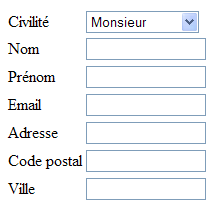Table des matières
Operation
The HTML page containing the form is free. Once in place, the platform locates the different variables (defined in the form parameters and present in the source), and replaces them with corresponding HTML fields (or the validate button in the case of a "submit" field).
The variable name is generated from the name chosen for the fields (the variable is surrounded by the % character and the special characters in the name are replaced).
The name of the variables is displayed in the second column of the "field management" page.
The drop-down list fields and the validate button have a default size.
Text and multiline text fields have a 100% width and height in their "style" property. It is therefore necessary to place them in a table cell with constrained dimensions in order to obtain the desired size. Their appearance can be modified by using normal tag CSS.
Simple example
In the following example, we have declared several fields:

The following HTML source has been placed in the form page:
<table border="0"> <tr> <td>Civilité</td> <td width="120">%civilite%</td> </tr> <tr> <td>Nom</td> <td width="120">%nom%</td> </tr> <tr> <td>Prénom</td> <td width="120">%prenom%</td> </tr> <tr> <td>Email</td> <td width="120">%email%</td> </tr> <tr> <td>Adresse</td> <td width="120">%adresse%</td> </tr> <tr> <td>Code postal</td> <td width="120">%code_postal%</td> </tr> <tr> <td>Ville</td> <td width="120">%ville%</td> </tr> </table>
The variables between the % sign are interpreted by the platform which generates the following HTML source code:
<table border="0"> <tr> <td>Civilité</td> <td width="120"><select name="champ_1"><option value="Monsieur">Monsieur</option><option value="Madame">Madame</option><option value="Mademoiselle">Mademoiselle</option></select</td> </tr> <tr> <td>Nom</td> <td width="120"><input type="text" name="champ_2" value="" style="width:100%;height:100%;"></td> </tr> <tr> <td>Prénom</td> <td width="120"><input type="text" name="champ_3" value="" style="width:100%;height:100%;"></td> </tr> <tr> <td>Email</td> <td width="120"><input type="text" name="champ_4" value="" style="width:100%;height:100%;"></td> </tr> <tr> <td>Adresse</td> <td width="120"><input type="text" name="champ_5" value="" style="width:100%;height:100%;"></td> </tr> <tr> <td>Code postal</td> <td width="120"><input type="text" name="champ_6" value="" style="width:100%;height:100%;"></td> </tr> <tr> <td>Ville</td> <td width="120"><input type="text" name="champ_7" value="" style="width:100%;height:100%;"></td> </tr> </table>
What displays:

Import a URL
The HTML page must be "well formed". If the HEAD and BODY tags (and STYLE if you use CSS) are not present, the import will not be done correctly. If you use a Dreamweaver-type HTML editor to create your pages, these tags are always present.
Links to other pages (e.g. on a website) must be absolute.
The links to the images to be imported must be absolute.
If a file to be downloaded is linked to the HTML page (a PDF file for example), check that the link is absolute.
Import of the URL
Copy the URL of the page into the MDWorks interface. After importing, check the content of the message body and style sheets.
In case of problems
If the body of the message is empty, check that your page contains <body> and </body> tags.
If the body of the message contains strange characters instead of accents, check that the charset of your page is in ISO-9001 (and not UTF-8).
Import a ZIP file
An HTML page can be imported with its images.
The HTML page must be "well formed". If the HEAD and BODY tags (and STYLE if you are using CSS) are not present, the import will not be done correctly. If you use a Dreamweaver-type HTML editor to create your pages, these tags are always present.
Links to other pages (e.g. on a website) must be absolute.
The links to the images to be imported must be relative.
If a file to be uploaded is linked to the HTML page (a PDF file for example), it will also be imported and hosted by this method. Check in this case that the link is relative.
Creating the ZIP file
To create the ZIP file, select directly the HTML page and the linked elements (images, directory, ...). Do not select the directory containing all this. The HTML page must be "at the root" of the ZIP file.
In case of problems
If the body of the message is empty, check that your page contains <body> and </body> tags.
If the body of the message contains strange characters instead of accents, check that the charset of your page is in ISO-9001 (and not UTF-8).
HTML editor
The form page can be created using the online HTML editor.
The places where the fields of the form should be placed must also be replaced by the variables between %..
Editing style sheets
Setting up the HTML source by importing a URL or a ZIP file, automatically fills in the stylesheet part according to the elements available in your original page.
However, you can modify the style sheets by hand to change the presentation.
This post is also available in:
 Français (French)
Français (French)
